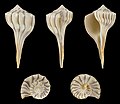Sinistrofulgur perversum
| Sinistrofulgur perversum | |
|---|---|

| |
| Sinistrofulgur perversum found in France, with the operculum in place | |
| Scientific classification | |
| Domain: | Eukaryota |
| Kingdom: | Animalia |
| Phylum: | Mollusca |
| Class: | Gastropoda |
| Subclass: | Caenogastropoda |
| Order: | Neogastropoda |
| Family: | Busyconidae |
| Genus: | Sinistrofulgur |
| Species: | S. perversum
|
| Binomial name | |
| Sinistrofulgur perversum (Linnaeus, 1758)
| |

| |
| Range | |
| Synonyms | |
Sinistrofulgur perversum, the lightning whelk, is a species of very large predatory sea snail or whelk, a marine gastropod mollusc in the family Busyconidae, the busycon whelks. This species has a left-handed or sinistral shell. It eats mostly bivalves.
There has been some disagreement about the correct scientific name for this species, which has been confused with Sinistrofulgur sinistrum Hollister, 1958, and Busycon contrarium (Conrad, 1840), which is an exclusively fossil species.[1][2]
-
Form with extensions
-
Form without extensions
Distribution
This marine species is native to the Mid-Atlantic region of the United States and southeastern North America, from New Jersey south to Florida and the Gulf states.
Habitat
Lightning whelks can be found in the sandy or muddy substrate of shallow embayments.
Life habits
This whelk species feeds primarily on marine bivalves, ingesting their soft parts using its proboscis.
Sinistrofulgur perversum and Busycon carica
This species shares many characteristics with another species, the knobbed whelk Busycon carica, but there are some important differences:[citation needed]
- Lightning whelks are sinistral in coiling, whereas knobbed whelks are dextral
- Lightning whelks have a lower spire than the knobbed whelk
- The knobs of the lightning whelk are usually less well-developed than those of the knobbed whelk
- Lightning whelks are diurnal, while knobbed whelks are active both day and night
- Lightning whelks prefer to stay in deeper waters than the knobbed whelks when feeding on mud flats
Human use
For thousands of years Native Americans used these animals as food, and used their shells for tools, ornaments, containers and to make jewelry, i.e. shell gorgets.[3] For example, the Indigenous peoples of Florida used their shells as hammers, axes, and cups; Floridan archaeologists have likened them to Swiss Army knives for their versatility.[4] They may have believed the sinistral nature of the lightning whelk shell made it a sacred object. The Minnesota Woman (lived c. 6000 BCE in modern Minnesota) wore a Sinistrofulgur perversum shell.[5]
The lightning whelk is the "State Seashell of Texas".[6]
Gallery
-
Live lightning whelk in North Carolina
-
Abapertural view of a shell
-
Egg cases
-
Egg cases in a museum
References
- ^ J. Wise, M. G. Harasewych, R. T. Dillon Jr. (2004). Population divergence in the sinistral whelks of North America, with special reference to the east Florida ecotone Archived 2012-08-24 at the Wayback Machine (PDF; 673 kB). Marine Biology 145, pp. 1167–1179.
- ^ Sartori, A. (2014). Busycon contrarium (Conrad, 1840). World Register of Marine Species. Accessed on 2014-06-06
- ^ Starr F. 1897. A Shell Gorget from Mexico. Proceeding Davenport Academy of Natural Sciences, volume VI. 173-178.
- ^ "Archaeological Shells of Florida" (PDF). Florida Public Archaeology Network. Retrieved 15 October 2024.
- ^ "TimePieces: Trade". Minnesota Historical Society. Archived from the original on 2004-11-06. Retrieved 2007-02-17.
- ^ Hatch, Rosie (Ed.) (2022). Texas Almanac 2022-2023. Austin, Texas: Texas State Historical Association. p. 23. ISBN 9781625110664.
- Marquardt, W.M. 1992 Shell Artifacts from the Caloosahatchee Area. In Culture and Environment in the Domain of the Calusa, edited by W. H. Marquardt, pp. 191–228. Institute of Archaeology and Paleoenvironmental Studies, Monograph 1. University of Florida, Gainesville.
- Paine, Robert T. 1962 Ecological Diversification in Sympatric Gastropods of the Genus Busycon. Evolution 16(4):515-523.
- Pulley, T.E. 1959 Busycon perversum (Linné) and some related species. Rice Institute Pamphlet, 46:70-89.
- Wise, J.B., G. Harasewych, & R. Dillon. 2004. Population divergence in the sinistral Busycon whelks of North America, with special reference to the east Florida ecotone. Marine Biology, 145:1163-1179; SMSFP Contrib.538.
External links
- Webarchive template wayback links
- Articles with short description
- Short description is different from Wikidata
- Articles with 'species' microformats
- All articles with unsourced statements
- Articles with unsourced statements from July 2018
- Commons category link is defined as the pagename
- Taxonbars with multiple manual Wikidata items
- Sinistrofulgur
- Commercial molluscs
- Seafood in Native American cuisine
- Gastropods described in 1758
- Taxa named by Carl Linnaeus
- Symbols of Texas






